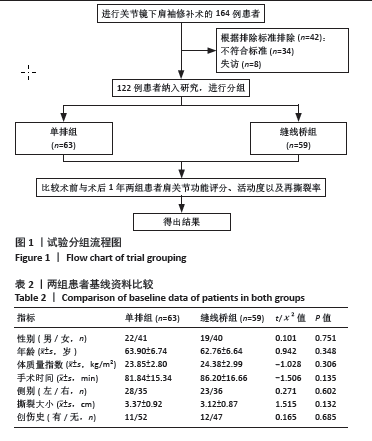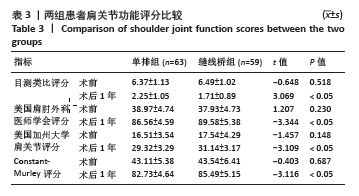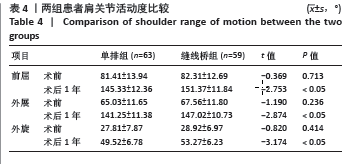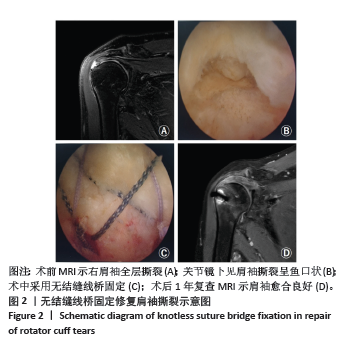[1] BEDEIR YH, SCHUMAIER AP, ABU-SHEASHA G, et al. Type 2 retear after arthroscopic single-row, double-row and suture bridge rotator cuff repair: A systematic review. Eur J Orthop Surg Traumatol. 2019;29(2):373-382.
[2] LAPNER P, HENRY P, ATHWAL GS, et al. Treatment of rotator cuff tears: A systematic review and meta-analysis. J Shoulder Elbow Surg. 2022;31(3): e120-e129.
[3] LAPNER P, LI A, POLLOCK JW, et al. A multicenter randomized controlled trial comparing single-row with double-row fixation in arthroscopic rotator cuff repair: Long-term follow-up. Am J Sports Med. 2021;49(11):3021-3029.
[4] MOON N, LEE SJ, KWAK SH, et al. Clinical and radiologic outcomes after arthroscopic rotator cuff repair: Single-row versus speed-bridge technique. Acta Orthopaedica Belgica. 2018;84(4):516-525.
[5] ŞAHIN K, ŞENTÜRK F, ERSIN M, et al. Repair integrity and functional outcomes between knot-tying and knotless suture-bridge arthroscopic rotator cuff repair: A prospective randomized clinical trial. Orthop J Sports Med. 2021;9(4):23259671211002482.
[6] HARRIS K, ZAGAR CA, LAWRENCE KV. Osteoporosis: Common questions and answers. Am Fam Physician. 2023;107(3):238-246.
[7] ENTEZARI V, LAZARUS M. Surgical considerations in managing osteoporosis, osteopenia, and vitamin d deficiency during arthroscopic rotator cuff repair. Orthop Clin North Am. 2019;50(2):233-243.
[8] HONG JP, HUANG SW, LEE CH, et al. Osteoporosis increases the risk of rotator cuff tears: A population-based cohort study. J Bone Miner Metab. 2022;40(2):348-356.
[9] JUNG SW, KIM DH, PARK TH, et al. Humeral head coverage in arthroscopic partial repair of massive rotator cuff tears improves functional outcomes: An analysis of influential factors. J Shoulder Elbow Surg. 2022;31(11):2233-2241.
[10] VECCHINI E, RICCI M, ELENA N, et al. Rotator cuff repair with single row technique provides satisfying clinical results despite consistent mri retear rate. J Orthop Traumatol. 2022;23(1):23.
[11] SANDOW MJ, SCHUTZ CR. Arthroscopic rotator cuff repair using a transosseous knotless anchor (atok). J Shoulder Elbow Surg. 2020;29(3): 527-533.
[12] NARVANI AA, IMAM MA, GODENÈCHE A, et al. Degenerative rotator cuff tear, repair or not repair? A review of current evidence. Ann Royal Coll Surg Eng. 2020;102(4):248-255.
[13] PARIKH N, MARTINEZ DJ, WINER I, et al. Direct and indirect economic burden associated with rotator cuff tears and repairs in the us. Curr Med Res Opin. 2021;37(7):1199-1211.
[14] FITZPATRICK LA, ATINGA A, WHITE L, et al. Rotator Cuff Injury and Repair. Semin Musculoskelet Radiol. 2022;26(5):585-596.
[15] PATEL M, AMINI MH. Management of Acute Rotator Cuff Tears. Orthop Clin North Am. 2022;53(1):69-76.
[16] CASTRO-CONTRERAS E, VALDEZ-PARDO ME. Rotator cuff injuries with nighttime pain and sleep quality before and after treatment. Acta Ortop Mex. 2022;36(1):33-38.
[17] LI C, ZHANG H, BO X, et al. Arthroscopic release combined with single-row fixation or double-row suture bridge fixation in patients with traumatic supraspinatus tear and adhesive capsulitis non-responsive to conservative management: A prospective randomized trial. Orthop Traumatol Surg Res. 2021;107(4):102828.
[18] DUKAN R, LEDINOT P, DONADIO J, et al. Arthroscopic rotator cuff repair with a knotless suture bridge technique: Functional and radiological outcomes after a minimum follow-up of 5 years. Arthroscopy. 2019;35(7):2003-2011.
[19] FREISLEDERER F, SCHEIBEL M. Arthroscopic knotless-anchor rotator cuff repair. JBJS Essent Surg Tech. 2020;10(3):e19.00021.
[20] MAZZOCCA AD, BOLLIER MJ, CIMINIELLO AM, et al. Biomechanical evaluation of arthroscopic rotator cuff repairs over time. Arthroscopy. 2010; 26(5):592-599.
[21] HEIN J, REILLY JM, CHAE J, et al. Retear rates after arthroscopic single-row, double-row, and suture bridge rotator cuff repair at a minimum of 1 year of imaging follow-up: A systematic review. Arthroscopy. 2015;31(11):2274-2281.
[22] LEE JB, KHOLINNE E, BEN H, et al. Clinical and Radiological Outcomes of Arthroscopic Superior Capsular Reconstruction Versus Primary Rotator Cuff Repair in Massive Rotator Cuff Tears: A Propensity Score-Matched Study. Am J Sports Med. 2023;51(8):1971-1978.
[23] ROSSI LA, CHAHLA J, VERMA NN, et al. Rotator Cuff Retears. JBJS Rev. 2020; 8(1):e0039.
[24] O’DONNELL EA, FU MC, WHITE AE, et al. The Effect of Patient Characteristics and Comorbidities on the Rate of Revision Rotator Cuff Repair. Arthroscopy. 2020;36(9):2380-2388.
[25] COTTER EJ, KLOSTERMAN EL, WINZENRIED AE, et al. Osteoporosis screening is often indicated but overlooked prior to rotator cuff repair. Arthroscopy. 2021;3(3):e659-e665.
[26] CHUNG SW, OH JH, GONG HS, et al. Factors affecting rotator cuff healing after arthroscopic repair: Osteoporosis as one of the independent risk factors. Am J Sports Med. 2011;39(10):2099-2107.
[27] PIETSCHMANN MF, FRÖHLICH V, FICKLSCHERER A, et al. Suture anchor fixation strength in osteopenic versus non-osteopenic bone for rotator cuff repair. Arch Orthop Trauma Surg. 2009;129(3):373-379.
[28] APRELEVA M, OZBAYDAR M, FITZGIBBONS PG, et al. Rotator cuff tears: The effect of the reconstruction method on three-dimensional repair site area. Arthroscopy. 2002;18(5):519-526.
[29] PAPALIA R, FRANCESCHI F, VASTA S, et al. Single- and double-row repair for rotator cuff tears - biology and mechanics. Med Sport Sci. 2012;57:122-141.
[30] LI X, XIAO Y, SHU H, et al. Risk factors and corresponding management for suture anchor pullout during arthroscopic rotator cuff repair. J Clin Med. 2022;11(22):6870.
[31] RO K, RHEE SM, KIM JY, et al. All-Suture Anchor Settling After Arthroscopic Repair of Small and Medium Rotator Cuff Tears. Am J Sports Med. 2019; 47(14):3483-3490.
|



